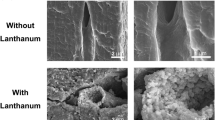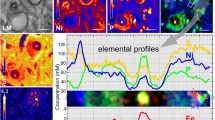Summary
The chemical nature of anionic sites located on both fronts of the endothelial cells (ECs) and in the basement membrane (BM) of mouse brain capillaries was studied using tissue sections embedded in Lowicryl K4M and cationic colloidal gold. Before labelling with cationic probe, the sections were digested with the following enzymes: trypsin, papain, pronase E, proteinase K, collagenase, chondroitinase ABC, hyaluronidase, heparinase, heparitinase, neuraminidase and endoglycosidase H.
The results indicate that the negatively charged surface layer on the luminal front differs in chemical nature from that on the abluminal front of the EC. Anionic sites located on the luminal surface of the plasmalemma of the ECs are mainly contributed by sialic acid residues of acidic glycoproteins. On the contrary, the anionic domains on the abluminal front of the EC represent mixed proteoglycan and acid glycopeptides containing hydrophobic amino acids, sialic acid residues, and are rich in heparan sulphate-bearing glycosaminoglycans. The anionic sites of the BM are contributed in a substantial degree by chondroitin and heparan sulphate-rich glycosaminoglycans.
The effect of endoglycosidase H suggests that glycopeptides containing oligomannosyl residues linked toN-acetylglucosa-mine contribute in small degree in maintenance of the negative charge in the BM, but not on the surfaces of the EC.
These results show that brain endothelium bears surface anionic domains differing chemically from those described for some fenestrated and continuous endothelia. The distribution of anionic sites indicates that the discrimination against various negatively charged molecules takes place on both fronts of the ECs as well as in the BM of brain micro-blood vessels. The exact role of these domains in the function of the blood-brain barrier remains to be established.
Similar content being viewed by others
References
Charonis, A. S., Tsilibary, P. C., Kramer, R. H. &Wissig, S. L. (1983) Localization of heparan-sulfate proteoglycan in the basement membrane of continuous capillaries.Microvascular Research 26, 108–15.
Charonis, A. S. &Wissig, S. L. (1983) Anionic sites in basement membrane. Differences in their electrostatic properties in continuous and fenestrated capillaries.Microvascular Research 25, 265–85.
De Bruyn, P. P. H. &Michelson, S. (1981) An anionic material at the advancing front of blood cells entering the bone marrow circulation.Blood 57, 152–6.
De Bruyn, P. P. H., Michelson, S. &Becker, R. P. (1978) Non random distribution of sialic acid over the cell surface of bristle coated endocytic vesicles of the sinusoidal endothelium cells.Journal of Cell Biology 78, 379–89.
Dermietzel, R., Thürauf, N. &Kalweit, P. (1983) Surface charges associated with fenestrated brain capillaries. II.In vivo studies on the role of molecular charge in endothelial permeability.Journal of Ultrastructure Research 84, 111–19.
Farquhar, M. G. (1981) The glomerular basement membrane. InCell Biology of Extracellular Matrix (edited byHay, E. D.), pp. 335–78. New York: Plenum.
Frens, G. (1973) Controlled nucleation for the regulation of the particle size in monodisperse gold suspensions.Nature Physical Science 241, 20–22.
Hardebo, J. E. &Kahrström, J. (1985) Endothelial negative surface charge areas and blood-brain barrier function.Acta Physiologica Scandinavica 125, 495–9.
Hart, M. N., Vandyk, L. F., Moore, S. A., Shasby, D. M. &Cancilla, P. A. (1987) Differential opening of the brain endothelial barrier following neutralization of the endothelial luminal anionic chargein vitro.Journal of Neuro-pathology and Experimental Neurology 46, 141–53.
Hopwood, D., Milne, G., Khan, M. A., Crisp, M. &Walker, M. (1983) Anionic groups in-basement membranes.Histochemical Journal 15, 491–8.
Houthoff, H. J., Moretz, R. C., Rennke, H. G. &Wisniewski, H. M. (1984) The role of molecular charge in the extravasation and clearance of protein tracers in blood-brain barrier impairment and cerebral edema. InRecent Progress in the Study and Therapy of Brain Edema (edited byGo, K. G. &Baethmann, A.), pp. 67–79. New York: Plenum.
Maxwell, W. L., Duance, V. C., Lehto, M., Ashurst, D. E. &Berry, M. (1984) The distribution of types I, III, IV and V collagens in penetrant lesions of the central nervous system of the rat.Histochemical Journal 16, 1219–29.
Millonig, G. (1961) A modified procedure for lead staining of thin sections.Journal of Biophysical and Biochemical Cytology 11, 736–9.
Nagy, Z., Peters, H. &Huttner, I. (1983) Charge-related alterations of the cerebral endothelium.Laboratory Investigation 49, 662–71.
Palade, G. E., Simionescu, M. &Simionescu, N. (1982) Differentiated microdomains in the vascular endothelium. InPathobiology of the Endothelial Cell (edited byNossel, H. L. &Vogel, H. J.), pp. 23–33. New York: Academic Press.
Pino, R. M. (1984) Ultrastructural localization of lectin receptors on the bone-marrow sinusoidal endothelium of the rat.American Journal of Anatomy 169, 259–72.
Pino, R. M. (1986a) The cell surface of a restrictive fenestrated endothelium. I. Distribution of lectin-receptor monosaccharides on the choriocapillaris.Cell and Tissue Research 243, 145–55.
Pino, R. M. (1986b) The cell surface of a restrictive fenestrated endothelium. II. Dynamics of cationic ferritin binding and the identification of heparin and heparan sulfate domains on the choriocapillaris.Cell and Tissue Research 243, 157–64.
Schmidley, J. W. (1987) Ultrastructural studies of basement membranes of microvessels isolated from rat brain: lack of staining with ruthenium red.Microvascular Research 33, 417–21.
Schmidley, J. W. &Wissig, S. L. (1986) Basement membrane of central nervous system capillaries lacks ruthenium red-staining sites.Microvascular Research 32, 300–14.
Schurer, J. W., Kalicharan, D., Hoedemaeker, P. J. &Molenaar, I. (1978) The use of polyethyleneimine for demonstration of anionic sites in basement membranes and collagen fibrils.Journal of Histochemistry and Cytochemistry 26, 688–9.
Simionescu, M., Simionescu, N. &Palade, G. E. (1982) Preferential distribution of anionic sites on the basement membrane and the abluminal aspect of the endothelium in fenestrated capillaries.Journal of Cell Biology 95, 425–34.
Simionescu, M., Simionescu, N., Santoro, F. &Palade, G. E. (1985) Differentiated microdomains of the luminal plasmalemma of murine muscle capillaries: segmentai variations in young and old animals.Journal of Cell Biology 100, 1396–407.
Simionescu, M., Simionescu, N., Silbert, J. E. &Palade, G. E. (1981) Differentiated microdomains on the luminal surface of the capillary endothelium. II. Partial characterization of their anionic sites.Journal of Cell Biology 90, 614–21.
Skutelsky, E. &Roth, J. (1986) Cationic colloidal gold — a new probe for the detection of anionic cell surface sites by electron microscopy.Journal of Histochemistry and Cytochemistry 34, 693–9.
Spurr, A. R. (1969) A low viscosity epoxy resin embedding medium for electron microscopy.Journal of Ultrastructural Research 26, 31–43.
Strausbaugh, L. J. (1987) Intracarotid infusions of prota-mine sulfate disrupt the blood-brain barrier of rabbits.Brain Research 409, 221–6.
Tai, T., Yamashita, K., Ogata-Arakawa, M., Koide, N., Muramatsu, T., Iwashita, S., Inoue, Y. &Kobata, A. (1975) Structural studies of two ovalbumin glycopep-tides in relation to the endo-N-acetylglucosaminidase specificity.Journal of Biological Chemistry 250, 8569–75.
Thürauf, N., Dermietzel, R. &Kalweit, P. (1983) Surface charges associated with fenestrated brain capillaries. I.In vitro labelling of anionic sites.Journal of Ultrastructure Research 84, 103–10.
Vorbrodt, A. W. (1987) Demonstration of anionic sites on the luminal and abluminal fronts of endothelial cells with poly-L-lysine-gold complex.Journal of Histochemistry and Cytochemistry 35, 1261–6.
Vorbrodt, A. W., Lassmann, H., Wisniewski, H. M. &Lossinsky, A. S. (1981) Ultracytochemical studies of the blood-meningeal barrier (BMB) in rat spinal cord.Acta Neuropathologica (Berl.) 55, 113–23.
Author information
Authors and Affiliations
Rights and permissions
About this article
Cite this article
Vorbrodt, A.W. Ultracytochemical characterization of anionic sites in the wall of brain capillaries. J Neurocytol 18, 359–368 (1989). https://doi.org/10.1007/BF01190839
Received:
Revised:
Accepted:
Issue Date:
DOI: https://doi.org/10.1007/BF01190839




